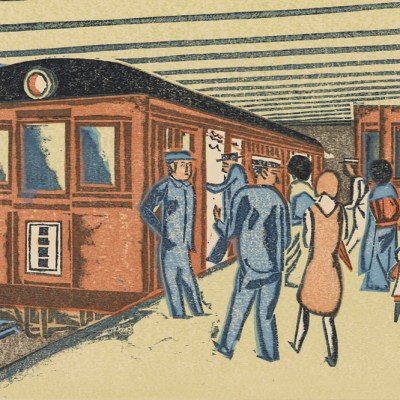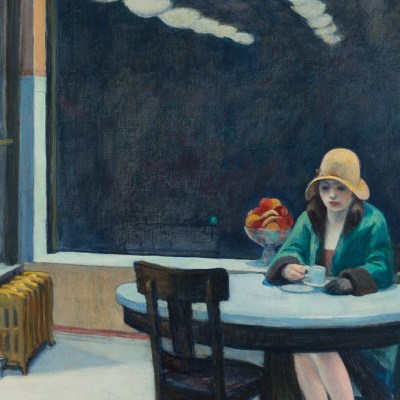Keita Morimoto is a nocturnal artist. He paints urban life between dusk and dawn, a lonely crepuscular cityscape of dark buildings and fluorescent lights. The brand-new works collected in ‘To Nowhere and Back’ (the majority date from 2025) at Almine Rech’s Tribeca gallery, construct a dreamlike picture of Tokyo after dark, where isolated figures gather at lonely intersections without ever meeting.
Morimoto was born in Osaka and in 2006 he moved to Canada to study art in Toronto. He returned to Japan in the winter of 2021, when the country was still locked down, and began to take walks at night, wandering Tokyo with a sketchbook and returning home to assemble scenes from his memories. His paintings filled up with convenience stores, phone booths and vending machines, lonely light-filled structures with, at most, a single figure set against them.
All these hallmarks can be seen at Almine Rech. In Crossroad, a pair of vending machines rest at the intersection of two streets, presenting the viewer with various gradations of light, from the deep blue of night to the red-orange warmth of sunrise on the horizon. We are in the midst of a slumbering cityscape of wires and homes. Yet the setting comes to seem anonymous, superfluous, and the eye is drawn towards those two well-stocked machines, which give off a light that illuminates only the machines themselves.
Crossroad (2025), Keita Morimoto. Photo: Shin Inaba; courtesy the artist and Almine Rech; © Keita Morimoto
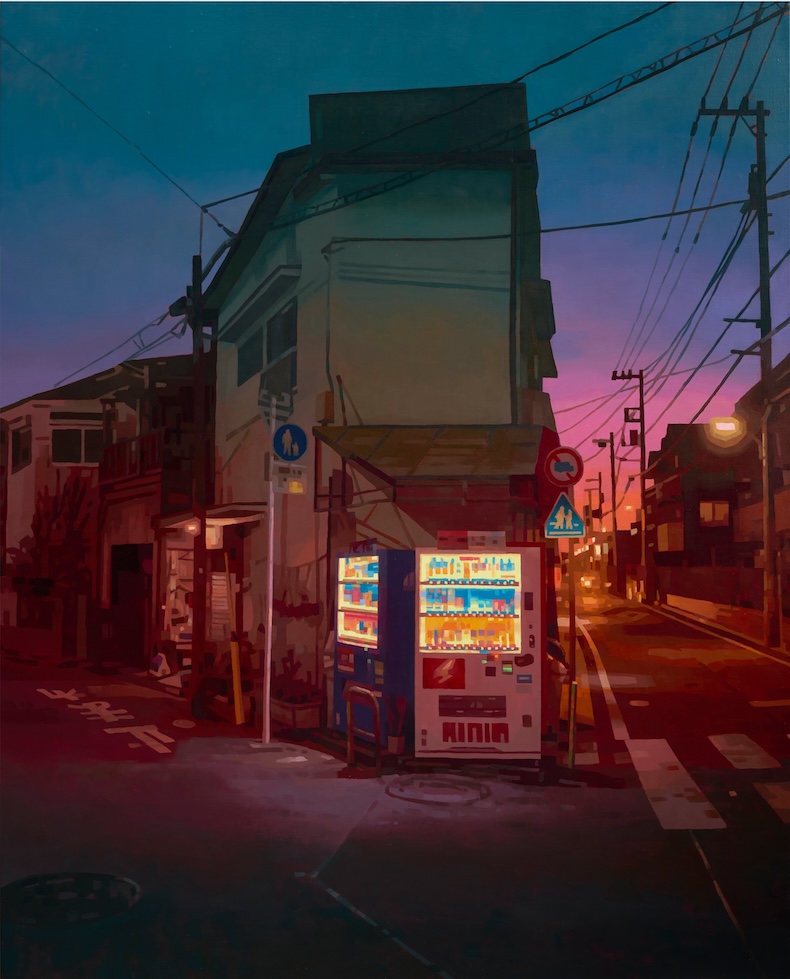
The Dutch masters concerned themselves with material subjected to light: bedrooms, side streets, maids bent over their needlework. Rembrandt and Bruegel have certainly left their imprint on Morimoto, but his subject is light, how it plays across the night sky, and especially those objects and places that shine from within like the saints in devotional art. He composes his scenes around light sources, bright punctums to which his eye repeatedly returns. ‘To Nowhere and Back’ features two paintings of convenience stores, one quiet and empty, the other clustered with passers-by. Yet only one figure stands out in the mammoth Green Room; all the others are blurred, effaced by the store’s mossy fluorescence. They seem less like individuals than moths drawn to the light.
When Morimoto chooses to paint realistic figures, his portraits are vivid and lifelike. Yet there is a subtle surrealism at work in those disconnected figures isolated uncomfortably within the same composition. To use the title of a recent exhibition, he paints pictures of ‘illuminated solitude’, exposing loneliness and disorientation to the piercing glare of electric light. In large-scale works such as Unseen Passage, grouped figures face the viewer in unnatural poses, surrounded by a world of life – shop signs, houselights, the blurred form of a passing car – yet separated from its flow. The actual objects are commonplace, yet their arrangement is mysterious and subtly strange. Having committed this nocturnal urban landscape to memory, Morimoto recomposes it into a map of endless liminal space, a network of sidewalks, junctions, and stairwells through which his ghostlike figures drowsily navigate.
Unseen Passage (2025), Keita Morimoto. Photo: Osamu Sakamoto; courtesy the artist and Almine Rech; © Keita Morimoto
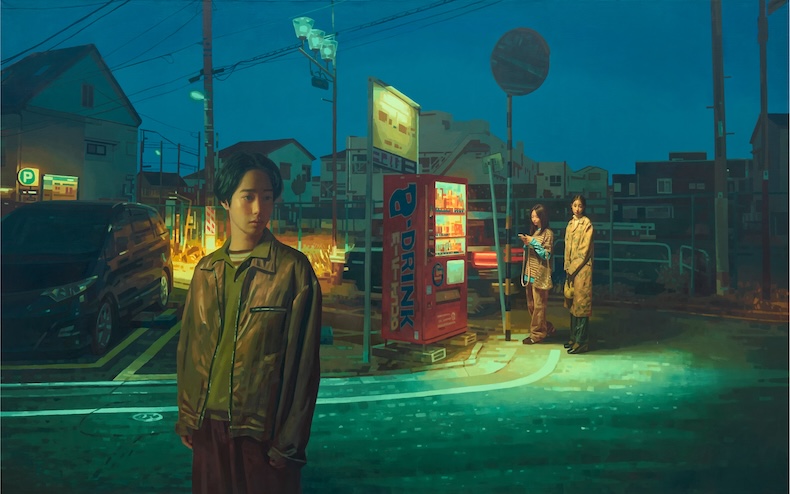
From across the gallery, the paintings can appear photorealistic, yet they break down at close range, separating into blocks of paint like the pixelation of a digital image. This abstraction gives texture to the flat, finished paintings; like the sprawling megacities they depict, these works are both dense and light. Their mystery and their power rest in this tension between the energy of Morimoto’s subjects and the stillness of his style, how he transforms a bustling city into a no-man’s-land of lonely objects and silent figures and manages to make alienation feel inviting and warm.
I first came across Morimoto’s work on Instagram. Those lonesome vending machines described so perfectly my own reality during the winter and spring of 2021, functional but without purpose, and absent human touch. During that first pandemic year I took long night-time walks across New York City, through empty backstreets and industrial zones. Wandering through the dark, I sometimes stopped to peer into a lit window, to gaze across the river at the skyscrapers, to take in a tree blooming wildly with flowers in the glow of a streetlight.
The light of those months was distant and inaccessible, marking places I could not enter, people I could not see. During those same bleak days, Morimoto was wandering the backstreets of Tokyo, painting his yearning for the city’s light-filled rooms. None of us are still living in that world. But in Morimoto’s work, the yearning remains.
Green Room (2025), Keita Morimoto. Photo: Osamu Sakamoto; courtesy the artist and Almine Rech; © Keita Morimoto
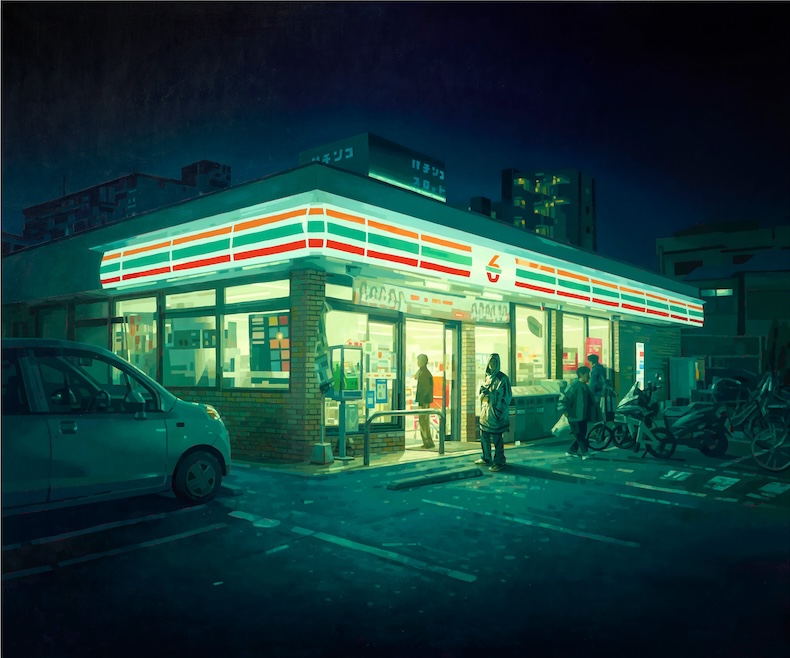
‘Keita Morimoto: To Nowhere and Back’ is at Almine Rech Gallery (Tribeca), New York, until 26 April.

